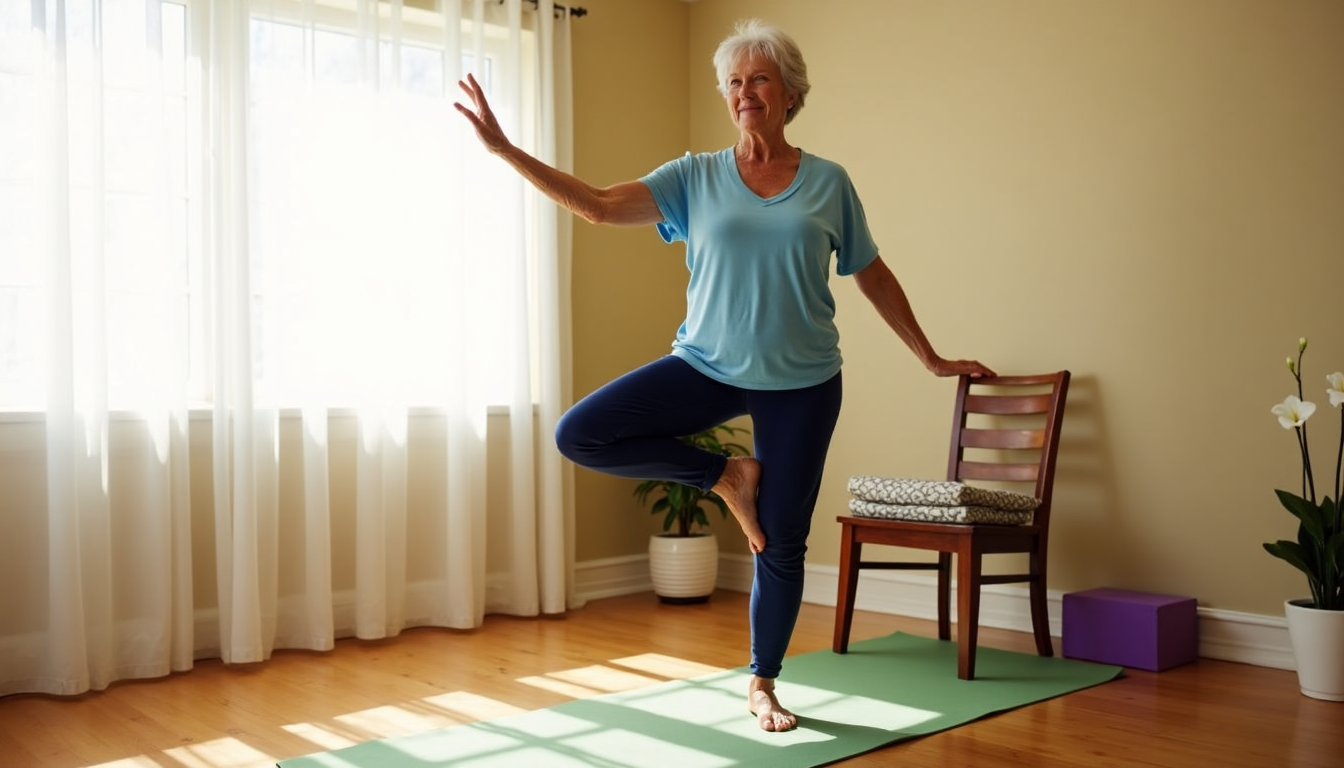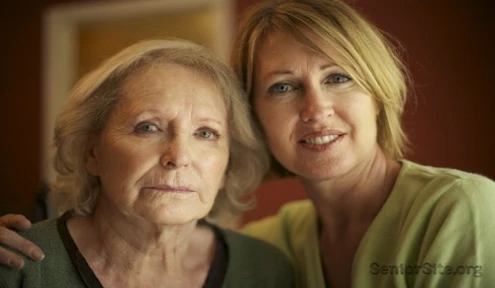Did you know that one in three seniors experiences a fall each year, and 50% of those have multiple falls?
However, there’s a gentle solution that’s gaining recognition among health experts. Beginning yoga for seniors isn’t just about flexibility – it’s a scientifically-backed way to improve balance, build strength, and enhance overall well-being. In fact, Harvard Health Publishing reports that regular yoga practice correlates with better sleep, improved body awareness, and greater balance.
Importantly, you don’t need to be flexible or athletic to start. Gentle yoga for seniors can be adapted to any fitness level, and research shows that even practicing simple poses for just 12 minutes a day can help maintain bone density – a crucial benefit as we age.
Whether you’re concerned about balance, looking to improve your strength, or simply wanting to enhance your overall well-being, we’ll show you exactly how to start your yoga journey safely and confidently. Let’s begin with the basics that every senior should know before stepping onto the mat.
Start with the Right Mindset
When approaching yoga for the first time in your 60s or beyond, your mindset matters most. I’ve found that mental preparation creates the foundation for a fulfilling practice that serves your body rather than straining it.
Why age is not a barrier to yoga
The perception that yoga is only for the young and flexible couldn’t be further from the truth. Scientific research consistently shows that yoga offers significant benefits for older adults. According to international exercise guidelines, yoga is specifically recommended for optimal aging and maintaining functional capacities in older adults, particularly for its balance and gait-promoting effects.
Furthermore, recent studies have demonstrated that yoga practice has positive effects on cellular aging, mobility, balance, mental health, and prevention of cognitive decline—all crucial concerns for seniors. Multiple meta-analyzes support that yoga-based interventions improve physical capability, cognition, and overall well-being.
Many seniors mistakenly believe they’re “too old” to begin, yet the evidence suggests otherwise. The quality of scientific evidence on yoga’s health benefits for seniors has improved significantly, showing small to moderate benefits comparable to other exercise programs. What’s particularly encouraging is that approximately 21% of adults aged 60 and older already practice yoga regularly.
Yoga adapts to you, not the other way around
One of the most beautiful aspects of yoga is its adaptability. Regardless of your current fitness level, there’s always a modification that works for your body. As one yoga instructor aptly noted, “I know so many who have started a practice not just after 50 but in their 90s and enjoyed more ease in all aspects of their lives. It’s simply never too late to begin”.
Letting go of perfection and comparison
When starting gentle yoga for seniors, comparing yourself to others is counterproductive. Research shows that comparative thoughts can seriously undermine your practice. As one expert explains, “Comparing yourself to others is a slippery slope that can go on and on and on, compromising your self-worth, self-esteem, and body image”.
Consequently, many beginners feel discouraged when they see more advanced practitioners. Nevertheless, remember that everyone starts somewhere, and yoga is fundamentally a personal journey, not a competition.
To enjoy the full benefits of beginning yoga for seniors, try these mindset shifts:
- Celebrate what’s possible today – Each day offers a different body to work with; let go of expectations about what poses should look or feel like
- Focus on breath and presence – When comparative thoughts arise, return to your breathing and stay present in your own experience
- Practice self-compassion – Approach your practice with kindness toward yourself, recognizing that insecurities often stem from self-judgment
The original purpose of yoga was to allow practitioners to become more in tune with the world and enter a deeper level of consciousness. This spiritual dimension remains relevant today, particularly for seniors seeking to connect more deeply with themselves.
Throughout my years of teaching yoga to seniors, I’ve observed that those who approach it with curiosity rather than self-criticism progress much further. They discover unexpected wells of strength and flexibility that have been dormant, sometimes for decades.
Starting yoga after 60 isn’t about mastering complex poses—it’s about moving inward and developing a deeper connection with your body. This inward journey represents one of yoga’s greatest gifts, especially in later years.
Prepare Your Space and Tools
Creating a proper yoga environment is just as important as having the right attitude. I’ve found that thoughtful preparation of your space and equipment directly impacts both safety and enjoyment, especially for beginning yoga for seniors.
Choosing a safe and quiet space
Privacy plays a crucial role in your yoga practice, allowing you to focus, breathe, and listen to what your body needs. Initially, look for a dedicated area in your home where you won’t be disturbed. This quiet mental space supports not only physical practice but also creates room for personal spiritual connection.
Once you’ve identified a suitable location, consider these safety elements:
- Choose a spot with ample room to place your mat and extend your arms without hitting anything
- Ensure the area has good lighting to see your movements clearly
- Check for potential hazards that might cause trips or falls
- Position yourself near a wall or sturdy furniture for standing poses to increase stability
Research indicates that practicing at home without a teacher’s supervision may increase injury risk. Subsequently, I recommend setting up your practice area in a location where you can easily follow video instructions if joining virtual classes.
Essential gear for gentle yoga for seniors
Although traditional yoga was practiced without modern equipment, today’s practitioners—particularly seniors—benefit from supportive props. The only truly essential equipment is a yoga mat, which serves two primary purposes: preventing slips and falls (the most common yoga injuries) and providing cushioning for your joints.
When selecting a mat for gentle yoga for seniors, consider thickness carefully:
- Thin mats (1.5mm): Provide better stability but less cushioning
- Standard mats (3mm): Offer balance between support and stability
- Thick mats (6mm): Provide extra cushioning for sensitive joints
A high-quality yoga mat typically costs between $90-$140, while budget options start around $20. Although initially more expensive, investing in a quality mat is worthwhile as it lasts longer and provides better safety features.
For yoga for elderly beginners, additional props can significantly enhance comfort and accessibility:
Chair: A sturdy, armless chair with a straight back is ideal for chair yoga, which offers an excellent option for seniors with limited mobility or balance issues. Ensure it doesn’t have wheels, allows your feet to rest flat on the floor, and can support dynamic movements.
Support props: Blocks, straps, or cushions help make poses more accessible. You might already have household items that work well—a firmly rolled Turkish towel can substitute for a yoga bolster.
Comfort accessories: For added comfort during yoga exercises for seniors, consider knee pads (15mm thick high-density foam pads provide excellent joint protection) and non-slip gloves or socks for improved stability.
Above all, remember that your equipment should adapt to your needs, not the other way around. As one expert explains, “Modify traditional yoga poses to accommodate any physical limitations or mobility issues”.
Begin with Breath and Body Awareness
Before diving into more complex poses, breathing exercises and gentle stretches create the essential foundation for beginning yoga for seniors. Indeed, these initial practices offer significant benefits on their own while preparing your body for further exploration.
Simple breathing exercises to calm the mind
Breathing is the cornerstone of any yoga practice. Moreover, controlled breathing techniques activate your body’s relaxation response, slowing heart rate, lowering blood pressure, and calming the nervous system. This helps promote a sense of calmness and mental clarity that’s especially valuable for seniors.
I recommend starting with these fundamental breathing practices:
- Diaphragmatic Breathing: Sit comfortably with your back straight and place one hand on your belly and the other on your lower ribcage. Breathe deeply through your nose, allowing your belly to expand first (notice your hand rising), followed by your ribcage. Exhale slowly and fully. Practice for 3-5 minutes daily, gradually building to 10 minutes.
- Coherent Breathing: Begin counting to 2 as you inhale, pause briefly, then exhale to the count of 2. As you progress, you can extend this count to 3, 4, or even 5. This regulated breathing pattern effectively reduces stress and brings your mind back to equilibrium, even during moments of anxiety.
- Three-Part Breath: Lying down comfortably, inhale deeply in three stages: first fill your belly, then your ribcage, finally your upper chest. Exhale in reverse order: empty your upper chest, ribcage, then belly. Practice for 10 breaths to start, focusing on keeping your mind clear and linked to the breath.
Gentle seated stretches to awaken the body
Once your breathing has calmed your mind, seated stretches help activate your body gently. For yoga for elderly beginners, chair yoga provides an excellent starting point.
Seated Mountain Pose: Sit tall with feet flat on the floor, hands resting on your thighs. This foundational pose establishes proper alignment and body awareness. From here, try these movements:
Seated Sun Breath: Inhale as you raise your arms above your head, bringing palms together if comfortable. Exhale as you lower your hands to heart center. This simple movement coordinates breath with motion, a fundamental yoga principle that enhances mindfulness.
Seated Cat-Cow: Place hands on your knees. Inhale and gently arch your spine, pushing your chest forward and looking slightly upward. Exhale and round your spine, looking toward your navel. Repeat several times, moving with your breath. This gentle movement enhances spinal flexibility and promotes body awareness.
Neck Stretch: With shoulders relaxed, gently tilt your right ear toward your right shoulder. Hold for several breaths, feeling the stretch along the left side of your neck. Repeat on the opposite side. This releases tension commonly held in the neck and shoulders of seniors.
These initial practices serve as the gateway to gentle yoga for seniors, helping develop the breath awareness and body connection that are fundamental to a safe, effective practice. Undeniably, mastering these basics before progressing to standing poses builds confidence and reduces injury risk for yoga for senior beginners.
Try Chair Yoga Before Standing Poses
Chair yoga serves as an excellent bridge between seated breathing exercises and full standing poses for anyone beginning yoga after 60. This approach allows you to build strength and confidence gradually while maintaining stability.
3 beginner chair yoga poses to build confidence
For yoga for senior beginners, practicing with a chair provides crucial support and stability. I recommend starting with these three foundational poses:
Seated Mountain Pose: Sit tall at the edge of your chair with feet flat on the floor, hip-width apart. Straighten your spine, relax your shoulders away from your ears, and place hands on your thighs. This foundational pose establishes proper alignment and can be practiced daily to improve posture.
Seated Cat-Cow: While sitting upright with feet planted on the floor, place hands on your knees. As you inhale, lift your chest and move your shoulders back, looking slightly upward (cow). Then exhale while rounding your back, bringing your chin toward your body (cat). Repeat this movement 5-8 times, flowing with your breath. This gentle movement enhances spinal flexibility.
Seated Pigeon Pose: From a tall seated position, place your right ankle onto your left thigh, keeping the right knee and ankle aligned. Hold this position for several breaths. For a deeper stretch, gently bend forward from the hips. This pose effectively releases tension in the hips—a common problem area for seniors.
Throughout these practices, remember that chair yoga offers similar benefits to traditional yoga but with added support for muscles and joints. Essentially, the chair brings the floor closer to you, making poses more accessible.
When to move from chair to standing yoga
Moving from seated to standing poses should happen gradually. First, ensure you can complete a 45-minute chair yoga session twice weekly without discomfort. Additionally, work on these prerequisites:
- You can perform chair poses with proper form and stable breathing
- Your balance has noticeably improved in everyday activities
- You can stand comfortably for several minutes
- Your healthcare provider approves more challenging exercise
Initially, use the chair as support for standing poses. Position it beside you to hold with one hand while performing gentle standing poses. For this purpose, many seniors begin with partial weight-bearing poses like Mountain Pose or gentle Forward Fold using the chair for balance.
As confidence grows, you might incorporate more challenging standing poses with chair support, such as Triangle Pose or Warrior I. Nevertheless, always listen to your body—if you experience pain, dizziness, or shortness of breath, return to seated practice.
Progress to Standing Poses Safely
Standing poses form the heart of traditional yoga practice, yet they require careful approach for seniors just beginning their yoga journey. Balance training is an often overlooked tool that can significantly reduce fall risks and subsequent injuries. With patient practice, these poses build confidence and quicken reaction time while enhancing body awareness.
2 easy standing yoga poses for balance
Mountain Pose (Tadasana): This foundational pose improves posture and balance while strengthening your feet, ankles, and legs.
- Stand with feet hip-width apart, weight evenly distributed across both feet
- Roll your shoulders up, back, and down while lifting your chest
- Relax your arms by your sides with palms facing outward
- Find your balance point and maintain steady breathing
If you struggle initially, try practicing near a wall for support. As your confidence grows, gradually move away from the wall.
Tree Pose (Vrikshasana): This gentle balancing pose strengthens core, hip, and leg muscles.
- Begin in Mountain Pose
- Shift weight onto your left foot
- Place your right foot against your left ankle (beginners) or inner thigh (advanced)
- Bring hands together at chest or raise above head if balance permits
- Focus on a fixed point to maintain stability
Make this pose easier by keeping one hand on a chair or wall for support. Practice on both sides to develop balanced strength.
Tips to avoid falls and joint strain
Balance training must be approached thoughtfully, primarily to prevent injuries. Start with these safety principles:
- Use proper support: Begin near a chair, wall, or solid surface until you gain confidence. This creates a safety net as you develop new skills.
- Engage your muscles: Activate your thigh muscles without locking your knees – this is critical for maintaining balance. Think of creating a gentle strength through your legs.
- Progress gradually: Follow the natural progression from chair yoga to standing poses with support, then independent standing. Research shows well-designed exercise programs reduce falls by approximately 25% among older adults.
- Smile through wobbles: Occasional wobbling is normal and actually helps develop balance systems. Each wobble strengthens your body’s ability to correct itself.
- Listen to your body: If you experience dizziness or discomfort, return immediately to a seated position. Safety always comes first in beginning yoga for seniors.
Throughout this process, remember that balance improves with continued practice. In time, these standing poses will strengthen your core, improve your stability, and ultimately enhance your confidence in daily activities.
Conclusion
Starting yoga after 60 brings remarkable benefits for both body and mind. Through my experience teaching seniors, I’ve seen how a gentle, progressive approach helps build confidence while improving balance and strength.
Certainly, the journey begins with the right mindset – accepting where you are today and letting go of comparisons. Additionally, proper preparation of your space and essential equipment creates a foundation for safe practice.
Your yoga path unfolds naturally as you progress from breathing exercises to chair poses, and eventually to standing poses. Each small step builds upon the last, creating lasting improvements in balance, flexibility, and overall well-being.
Therefore, I encourage you to start slowly, listen to your body, and celebrate small victories along the way. The physical and mental benefits of yoga practice will undoubtedly enhance your daily life, helping you stay active and independent as you age.
Lastly, remember that yoga adapts to meet you exactly where you are. Whether practicing in a chair or standing tall in Mountain Pose, your unique journey holds endless possibilities for growth and discovery.
FAQs
Q1. Is it safe to start yoga after 60? Yes, it’s safe to start yoga after 60. Yoga can be adapted to any fitness level and offers numerous benefits for seniors, including improved balance, strength, and flexibility. Always consult your healthcare provider before beginning any new exercise routine.
Q2. What equipment do I need to start yoga as a senior? To start yoga as a senior, you’ll need a yoga mat for cushioning and stability. Additional helpful items include a sturdy chair for support, yoga blocks, and straps to assist with poses. Comfortable, breathable clothing is also important.
Q3. How often should seniors practice yoga? Seniors should aim to practice yoga 2-3 times a week to start. Begin with short sessions of 15-20 minutes and gradually increase duration as your strength and flexibility improve. Listen to your body and rest when needed.
Q4. Can I do yoga if I have balance issues? Absolutely. Yoga can actually help improve balance. Start with chair yoga or use a wall for support during standing poses. As your balance improves, you can gradually progress to more challenging poses. Always prioritize safety and move at your own pace.
Q5. What are some beginner-friendly yoga poses for seniors? Some beginner-friendly yoga poses for seniors include Seated Mountain Pose, Chair Cat-Cow, Seated Pigeon Pose, and standing Mountain Pose. These poses help improve posture, flexibility, and balance while being gentle on the joints. Remember to breathe deeply and move slowly through each pose.












